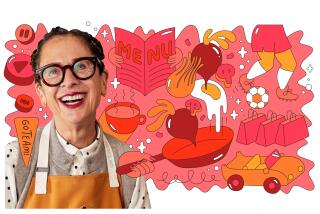Fannyâs Cookbook--a Testament to the Evolving Immigrant Taste
I have one serious failing--in or out of the kitchen--I lose things. Not a day goes by that I do not misplace some object so vital to my existence that the entire household must be torn apart for its retrieval. That goes for my razor, reading glasses, money and recipe books, too.
Last fall, after a guest appearance with some other cookbook authors at the Miami Book Fair, I was approached by a woman in the audience. She introduced herself as Fanny Silverstein, not only a fan, but also a cookbook writer. Silverstein was 78 at the time; her first cookbook had just been published and she offered to send me a copy. It was a gift that I accepted with certain misgivings, because although I liked Silverstein at first sight, I was not altogether convinced I would have the same reaction to her recipes. For I am not a lover of traditional Jewish cooking; luckily for me, neither is Silverstein.
Her book, âMy Motherâs Cookbookâ (Carroll & Graf/Quicksilver: $16.95, 1985), is only part recipes; most of the tome is a guileless memoir of the young-and-old Silversteinâs life and times at the stove.
Instantly Engaging Reading
When the book arrived I intended to give it a cursory glance but became instantly engaged by the authorâs adventures--starting as an immigrant girl cooking in New Yorkâs Lower East Side and ending up as the personal chef to the head of Paramount Pictures and cooking a Passover dinner for Marilyn Monroe. I read it from cover to cover. Then promptly lost it.
I only realized âMy Motherâs Cookbookâ was gone when I wanted to write about it. I had made a random promise to the authorâs son, who had published the book, that I would review it if I liked it. But I didnât realize how much I liked it until the book vanished. I searched for it for weeks. Then I called book stores and ethnic newspaper book reviewers. However, the odd thing is by this time I could no longer remember the bookâs title, the authorâs name, nor her sonâs publishing company. Everything about this book evaporated into thin air.
In desperation I even called the organizer of the book fair. She dimly recalled the woman I described meeting at the event but had no clue to her identity either.
âBut not to worry,â she assured me. âI do an hourlong radio show every week about cookbooks. Iâll put out a missing person search on the lady in question.â
I worried anyway. Rightly so, for after three weeks of talk radio, the author was still a missing quotient.
Just when I decided to give up, the authorâs son wrote me a note. He remembered my promise and thought he might have missed a column I wrote about his mother.
A Happy Ending
Thatâs how happy endings come about. I never found the missing book. But I have a replacement copy autographed and dogeared with all the recipes I have tried and plan to make in the future.
âFanny in the kitchen,â she writes in her book, âI suppose that is where I am happiest, where I am most at home. When I was teaching cooking, I could get the message across one to one, person to person. Now I am writing a book, and more than anything else would like to accomplish the same thing, namely: to take the mystery out of cooking and fear out of the kitchen.â
Itâs a credo every cookbook writer might do well to subscribe to. Silversteinâs recipes are not meant for novices. She is a woman who has spent her life cooking with such verve and gusto that she does not feel compelled to mete and measure every dash of salt or pepper. Good cooks will revel at her freedom. Not a kosher cookbook, this is a testament to the immigrant taste as it changed and flowered on American soil.
If you canât find a copy at a bookstore, order directly from the publishers: Carroll & Graf/Quicksilver Books, 260 5th Ave., New York, N.Y. 10001.
This is a slightly amended version of a one-dish dinner from Silversteinâs collection. According to Silverstein, âIt was baked overnight because Orthodox Jews do not cook on the Sabbath and such a dish made it possible for them to have a hot meal while still observing their religious rituals.â
FANNY SILVERSTEINâS CHOLENT
3 tablespoons oil
1 (3 1/2- to 4-pound) boneless chuck roast
1 medium onion, finely chopped
1 clove garlic, minced
1 teaspoon salt
1/4 teaspoon freshly ground black pepper
1 teaspoon hot Hungarian paprika
1/2 teaspoon ground ginger
2 quarts beef broth
1 cup dried pink beans
1 cup barley
Chopped fresh parsley
Heat oil in large Dutch oven over medium-high heat until hot but not smoking. Brown roast well on all sides. Remove roast to plate. Reduce heat under Dutch over to medium.
Add onion to Dutch oven and cook, scraping bottom and sides of pot with wooden spoon, 3 minutes. Add garlic. Cook 2 minutes longer. Stir in salt, pepper, paprika and ginger. Stir well and add beef broth. Heat to boiling.
Stir in beans and barley. Return mixture to boiling and add roast.
Place pot in 250-degree oven and cook 2 1/2 hours. Stir mixture and continue to cook, partially covered, until meat is very tender, about 1 1/2 hours longer. Remove cover completely, if mixture is too wet.
To serve, remove meat and slice. Spoon bean and barley mixture into large shallow serving dish and place meat over top. Sprinkle with parsley. Makes 6 to 8 servings.
More to Read
Eat your way across L.A.
Get our weekly Tasting Notes newsletter for reviews, news and more.
You may occasionally receive promotional content from the Los Angeles Times.










